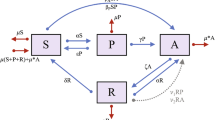Abstract
Everingham and Rydell’s [1] Markov chain model of cocaine demand is modified and updated in light of recent data. Key insights continue to hold, e.g., that the proportion of cocaine demand stemming from heavy vs. light users changed dramatically over the 1980s. New insights emerge, e.g., pertaining to the average duration of a career of heavy use (about 12 years) and the negative relationship between levels of heavy use and epidemic “infectivity” or the number of new initiates per current user per year. This illustrates how simple modeling can yield insights directly relevant to managing complex drug control policy questions.
Similar content being viewed by others
References
S.S. Everingham and C.P. Rydell, Modeling the Demand for Cocaine, MR-332-ONDCP/A/DPRC (RAND, Santa Monica, 1994).
Office of National Drug Control Policy (ONDCP), What America’s Users Spend on Illegal Drugs (The White House, Washington, D.C., 2001).
S.S. Everingham, P. Rydell and J.P. Caulkins, Cocaine consumption in the US: Estimating past trends and future scenarios, Socio-Economic Planning Sciences 29 (1995) 305–314.
J.P. Caulkins, Drug policy: Insights from mathematical analysis, in: Handbook of OR/MS Applications in Healthcare, eds. F. Sainfort, W. Pierskalla and M. Brandeau (2004).
C.P. Rydell and S.S. Everingham, Controlling Cocaine, Supply Versus Demand Programs (RAND, Santa Monica, 1994).
C.P. Rydell, J.P. Caulkins and S. Everingham, Enforcement or treatment: Modeling the relative efficacy of alternatives for controlling cocaine, Operations Research 44 (1996) 687–695.
J.P. Caulkins, C.P. Rydell, W.L. Schwabe and J. Chiesa, Mandatory Minimum Drug Sentences: Throwing Away the Key or the Taxpayers’ Money? MR-827-DPRC (RAND, Santa Monica, 1997).
J.P. Caulkins, C.P. Rydell, S.S. Everingham, J. Chiesa and S. Bushway, An Ounce of Prevention, a Pound of Uncertainty: The Cost-Effectiveness of School-Based Drug Prevention Program MR-923-RWJ (RAND, Santa Monica, 1999).
J.P. Caulkins, S. Paddock, R. Pacula and J. Chiesa, School-Based Drug Prevention: Kind of Drug Use Does it Prevent? MR-1459-RWJ (RAND, Santa Monica, 2002).
J. Kaplan, The Hardest Drug: Heroin and Public Policy (University of Press, Chicago, 1993).
J.P. Caulkins, The dynamic character of drug problems, Bulletin on Narcotics 53(1) (2001) 11–23.
D.F. Musto, The American Disease (Yale University Press, New Haven, 1973).
M.A.R. Kleiman, Against Excess: Drug Policy for Results (Basic Books, New York, 1992).
D.A. Behrens, J.P. Caulkins, G. Tragler, J. Haunschmied and G. Feichtinger, A dynamic model of drug initiation: Implications for treatment and drug control, Mathematical Biosciences 159 (1999) 1–20.
D.A. Behrens, J.P. Caulkins, G. Tragler and G. Feichtinger, Optimal control of drug epidemics: Prevent and treat – but not at the same time? Management Science 46(3) (2000) 333–347.
D.A. Behrens, J.P. Caulkins, G. Tragler and G. Feichtinger, Why present-oriented societies ungergo cycles of drug epidemics, Journal of Economic Dynamics and Control 26(6) (2002) 919–936.
R.A. Johnson, D.R. Gertstein, P. Ghadialy, W. Choy and J. Gfroerer, Trends in the Incidence of Drug Use in the United States, 1919–1992, Substance Abuse and Mental Health Services Administration, Office of Applied Studies, US Department of Health and Human Services (1996).
C. Knoll and D. Zuba, Modeling the US cocaine epidemic: Dynamic trajectories of initiation and demand, Masters Thesis at the Technical University of Vienna (2002).
Substance Abuse and Mental Health Services Administration (SAMHSA), Selected Tables from the National Household Survey on Drug Abuse, Table H.43, www.samhsa.gov/oas/NHSDA/2k1NHSDA/vol2/appendixh_3.htm#tableh.43(2002).
P.G. Hoel, S.C. Port and C.J. Stone, Introduction to Stochastic Processes (Houghton Mifflin Co, Boston, 1972).
H. Harwood, D. Fountain and G. Livermore, The economic costs of alcohol and drug abuse in the United States, 1992, U.S. Department of Health and Human Services, Washington, DC (1998).
C.F. Manski, J.V. Pepper and C.V. Petrie, Informing America’s Policy on Illegal Drugs: What We Don’t Know Keeps Hurting Us (National Academy Press, Washington, DC, 2001).
Office of National Drug Control Policy, What America’s Users Spend on Illegal Drugs, 1988–1998 (The White House, Washington, DC, 2000).
D. Winkler, J.P. Caulkins, D. Behrens and G. Tragler, Estimating the relative efficiency of various forms of prevention at different stages of a drug epidemic, Socio-Economic Planning Sciences 38 (2004) 91–109.
J.P.Caulkins and S.Chandler, Long-run trends in incarceration of drug offenders in the US, in submission.
Author information
Authors and Affiliations
Corresponding author
Rights and permissions
About this article
Cite this article
Caulkins, J.P., Behrens, D.A., Knoll, C. et al. Markov Chain Modeling of Initiation and Demand: The Case of the US Cocaine Epidemic. Health Care Manage Sci 7, 319–329 (2004). https://doi.org/10.1007/s10729-004-7540-4
Issue Date:
DOI: https://doi.org/10.1007/s10729-004-7540-4




